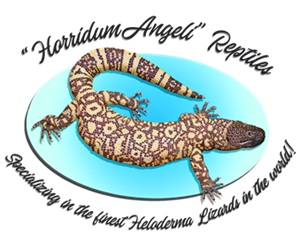
- New Mexico Milksnake
Big Bend Milksnake
- Lampropeltis triangulum celaenops
- Size:
- Hatchling: 6 - 8 in.
- Adult: 24 - 36 in.(normal)
- Scalation:
- Dorsal: 21 - 25 rows
- Ventral: avg. of 202, 198 - 207
- Sub caudal: 60
- Infra labial:8 - 11
- Supra labial: 7
- Anal Plate: Single
|
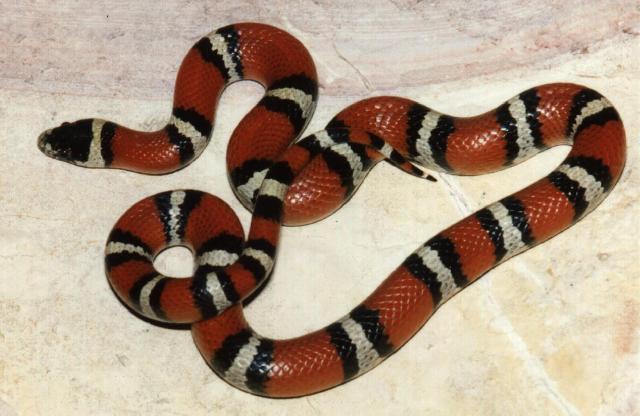
Photo by Troy Hibbitts
click to enlarge |
Written by Troy Hibbitts
- Common Name:
- Big Bend or New Mexico Milksnake
- Scientific Name:
- Lampropeltis triangulum celaenops
- Size:
- Hatchling: 6 - 10 inches
- Adult: 16 - 36 inches
- Scalation:
- Dorsal: Usually 21 scale rows at the neck and midbody, reducing to 19
or 17 at the vent.
- Ventral: 179 - 190 in males, 170 - 194 in females
- Subcaudald: 40 - 53 in males, 41 - 42 in females (only 2 sampled)
- infralabials: 7 - 9 (usually 9)
- Supralabials: 6 - 7 (usually 7)
- Anal Plate: Single
- Coloration:
- Head:
The head is usually black except for white mottling on the
supralabials, the internasals, and sometimes part of the frontals.
Some specimens have much more extensive white on their heads, especially on
thier snouts, temporals and supralabials. On occasional individuals, there
are scattered red flecks in the black area of the head; rarely, individualswill have large red patches or extensively red heads.
- Dorsal:
From 17 to 25 triads of red, black and white; the average is 21.
The white rings are usually about one and a half to 3 scales wide, the black
rings range from one and a half to 3 scales wide, and the red body rings usually
are from 2 to 5 scales wide.
Many celaenops have white rings of intense "styrofoam white", unmarred
by black flecking. In some specimens, the light rings are cream to yellow in
color, while on some individuals the white rings are heavily invaded with black
flecking, producing a grayish color. The red, too, varies from individual to
individual, as well as between populations. In some specimens, the red is a vivid
"candy-apple" or "fire-engine" color, in others it can be fairly dull to nearly brown,
while still other specimens have a very deep red color.
Several anerythristic specimens have been collected, and these pattern
variants are being bred commercially.
- Ventral:
The white dorsal rings generally cross the ventral surfaces uninterrupted,
while the red rings are bordered on the edges of the ventrals by black pigment
producing a central light area, which in many specimens is invaded by black, although
usually not as dark as in annulata.:
- Behavior:
- Celaenops can be found from April to late October or early November. It is
usually only surface active at night. Only very few celaenops are field collected
under rocks, usually from April through May. My wife Marla caught a gravid female
under a rock near San Angelo in mid-May, and my dad and brother caught two males
in the same area on April 1. All were collected under limestone rocks. The primary
method of finding celaenops is to find them crossing roads at night or on road cuts.
Celaenops can be nervous and jumpy snakes, although most settle down in captivity
quite nicely. One of my wild-caught females calmly accepted a pre-killed fuzzy mouse from
my hands only days after capture.
- Breeding:
- Celaenops require a 3 month brumation period in order to stimulate breeding, much
like other temperate species of kingsnakes. Breeding will usually commences
shortly after the animals are warmed up. The male will usually bite the female
behind the head while copulating, and copulation can occur for an extended period of
time (several hours). A clutch of 2 to 9 eggs will be laid 30-40 days after fertilization.
Egg size (and therefore neonate size) depends largely upon the size of the female.
Incubation usually takes about 60 days at 82 degrees Farhenheit.
- Range:
- This subspecies is found from west-central Texas (Abeline/San Angelo areas) west
through the Trans Pecos of Texas and throughout much of New Mexico, including the
eastern plains of New Mexico and the Mesilla Valley. Scattered records exist for
much of New Mexico, and the exact range of this subspecies is not well defined.
Celaenops probably also extends into northern Mexico; however, no records for this
subspecies exist for that country.
Specimens from San Angelo and Abeline have been considered by many authorities
to be either annulata or annulata/gentilis intergrades. The ten specimens from this region
that I have examined all appear to be much closer to celaenops than any other form. Celaenops
intergrades with gentilis throughout the center of the Texas Panhandle. Records
of celaenops from extreme northwestern New Mexico are considered to be taylori/celaenops
intergrades. Recent specimens of milksnake collected in extreme southwestern New Mexico
and southeaster Arizona are not identifiable to any subspecies; they may represent populations
of celaenops or an entirely new subspecies.
- Habitat:
- Celaenops seems to prefer rocky grassland habitats throughout its range, although it
ranges up into the pinyon/juniper region of Texas' and New Mexico's mountains, and down
Chihuahuan thornscrub along the Rio Grande from Lozier Canyon to Presidio County,
Texas. It is also common in sandy deserts of the northeastern Trans-Pecos of Texas and
eastern New Mexico. In rocky areas, it is found primarily on limestone and igneous
substrates.
- Prey:
- Most wild celaenops probably eat mostly lizards: Skinks (Eumeces), Fence Lizards
(Sceloporus, Uta, and Urosaurus), earless lizards (Cophosaurus, Holbrookia), and
whiptails (Cnemidophorus). Small snakes (Tantilla, Sonora, and Leptotyphlops) are also
eaten, as are small mice (Perognathus, Chaetodipus, and Peromyscus). In captivity,
juveniles can usually be started easily on meals of lizard-scented pinks, and can usually
be switched to unscented mice in short order. Wild caught adults typically feed readily
on pre-killed lab mice (fuzzies or small weanlings).
- Literature Cited:
-
Conant, R. and J.T. Collins. 1991. Reptiles and Amphibians of Eastern/Central North
America. Houghton Mifflin, Co., Boston.
-
Deghenhart, W.G., C.W. Painter, and A.H. Price. 1996. Amphibians and Reptiles of New
Mexico. University of New Mexico Press, Albuquerque.
-
Williams, K.L. 1988. Systematics and natural history of the American milk snake
(Lampropeltis triangulum), 2nd revised edition . Milwaukee Public Museum.
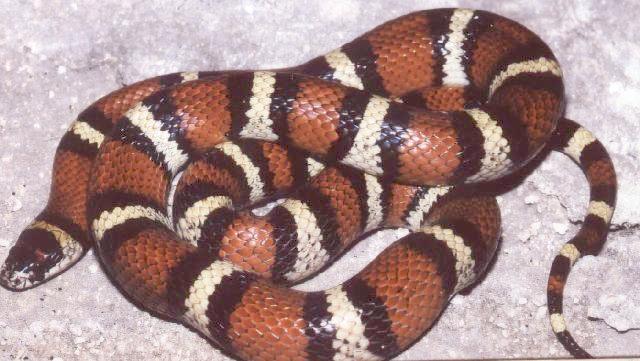
Photo by Troy Hibbitts
Click to Enlarge |
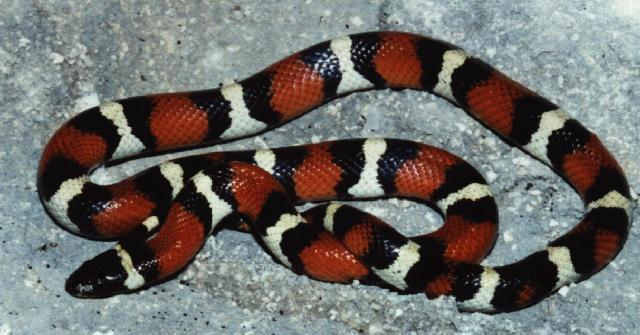
Photo by Troy Hibbitts
Click to Enlarge |
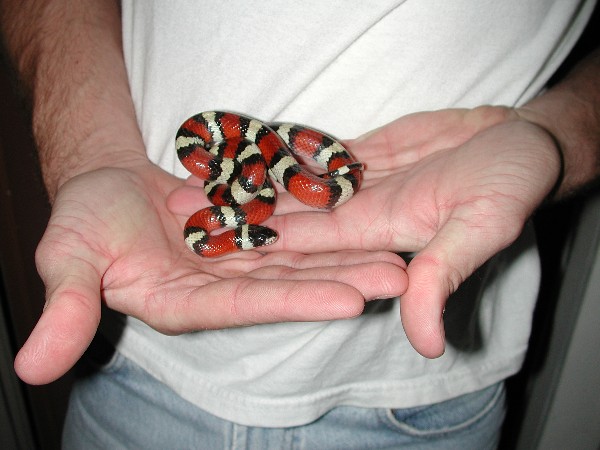
Gallery Photo by alterna63
Click to Enlarge |
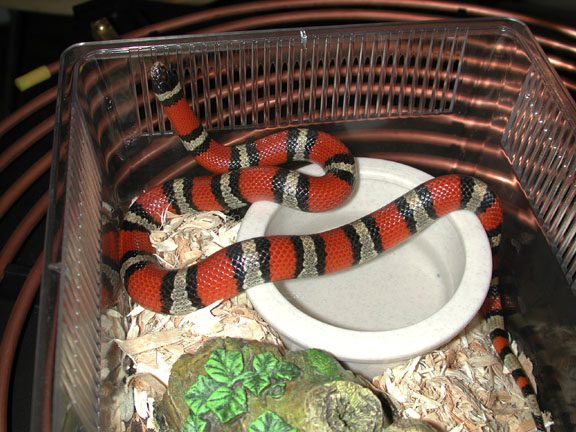
Gallery Photo by coils
Click to Enlarge |
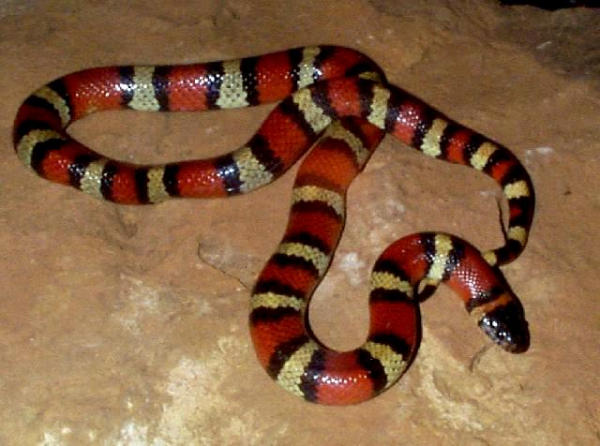
Gallery Photo by Jeff Barringer
Click to Enlarge |
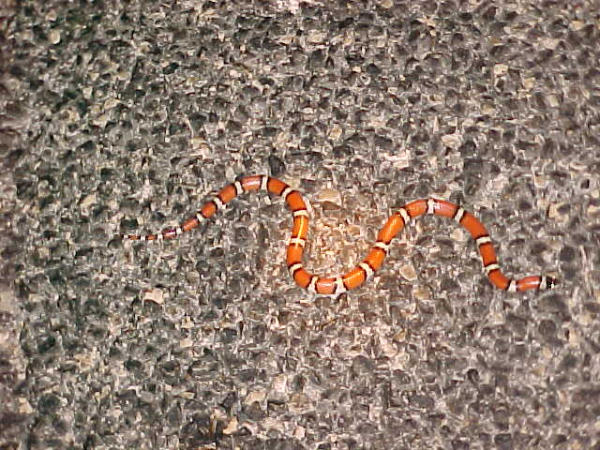
Gallery Photo by John Fraser
Click to Enlarge |
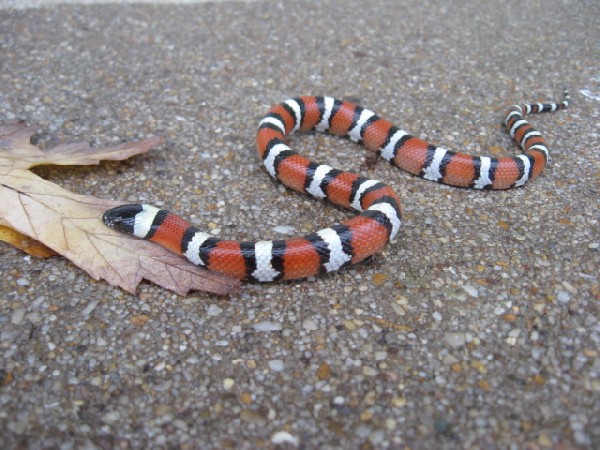
Photo by Patton
Click to Enlarge |
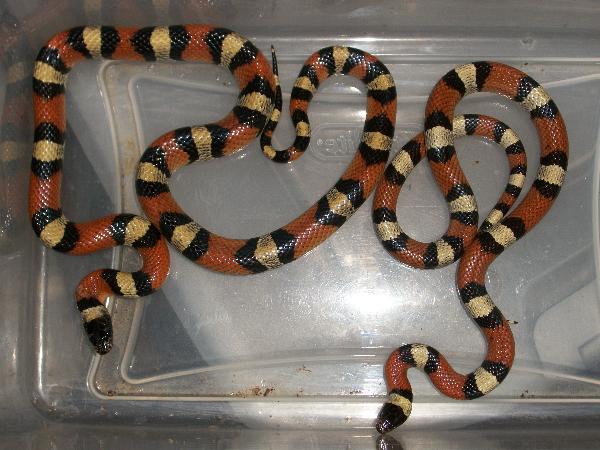
Photo by Samantha Bottoms
Click to Enlarge |
|
|
Sponsored Link
New & Updated Business Listings
Looking for a reptile or amphibian related business? A reptile store, breeder, importer,
maunfacturer or supplier? Our business directory lists some of the most popluar herp businesses in the world.
| Locate a reptile or amphibian business by name:
|
|
Recent Milk Snake Forum Forum Posts
• I'm here, too!, posted by Sunherp
• Kingsnake lives!, posted by exposito
• Hey Everybody, I'm here., posted by AaronBayer
• Scott Ballard Provided A Wealth Of Info, posted by Ameron
• Central America Milksnake Dilemma, posted by Ameron
• Retun to Forum / New Stuart's Milksnake , posted by Ameron
• Eggs ok?, posted by highley1980
• Splotched Sinaloan Variety, posted by bslugger551
• Splotched/Bullseye Sinaloans, posted by bslugger551
• Is my milk snake is getting TOO HOT?, posted by darbellah
• New owner looking for advice, posted by Irishfran
• New adoption biting and chewing fingers, posted by ajcur17
• Help*** Our milksnake won’t eat., posted by KieranSnake
• "trouble" with my milk snake, posted by kedjkd
• L. annulata (Mexican Milk) temps, posted by JJJ
Recent Milk Snake Classifieds:
- WANTED Milksnakesall spe...
- 4 foot Sinaloan Milksnak...
- 10 Adult Pueblan milk
Banner Pool
Reptile & Amphibian Events
|














